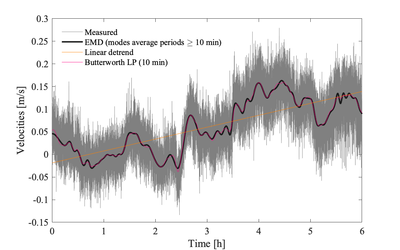Detrending time series: Difference between revisions
From Atomix
m Fixing refs |
m Added image |
||
| Line 13: | Line 13: | ||
* Empirical modal decomposition | * Empirical modal decomposition | ||
[[File:Long timeseries.png|400px|thumb|caption]] | |||
==Notes== | ==Notes== | ||
Revision as of 17:25, 29 November 2021
In the context of analysing turbulence observations, detrending typically refers to removing the low-frequency signal such that the signal retains contributions from turbulence and surface waves (if present). In ocean environments, this time scale is usually of the order of minutes.
There is no exact definition for what consists of a "trend", nor any set algorithm for identifying the trend [1]. The following techniques can be used for detrending [1]:
- Linear trend removal
- Low-pass filtering using moving averages or linear filters (e.g., butterworth filter)
- Empirical modal decomposition

Notes
- ↑ 1.0 1.1 {{#arraymap:Zhaohua Wu, Norden E. Huang, Steven R. Long, and Chung-Kang Peng|,|x|x|, |and}}. 2007. On the trend, detrending, and variability of nonlinear and nonstationary time series. PNAS. doi:10.1073/pnas.0701020104
